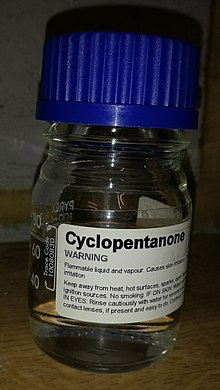| |||

| |||
| Names | |||
|---|---|---|---|
| Preferred IUPAC name Cyclopentanone | |||
| Other names
Ketocyclopentane Adipic ketone | |||
| Identifiers | |||
| CAS Number | |||
| 3D model (JSmol) | |||
| ChEBI | |||
| ChEMBL | |||
| ChemSpider | |||
| ECHA InfoCard | 100.004.033 | ||
| KEGG | |||
| PubChem CID | |||
| RTECS number |
| ||
| UNII | |||
| CompTox Dashboard (EPA) | |||
InChI
| |||
SMILES
| |||
| Properties | |||
| Chemical formula | C5H8O | ||
| Molar mass | 84.12 g/mol | ||
| Appearance | clear, colorless liquid | ||
| Odor | peppermint-like | ||
| Density | 0.95 g/cm, liquid | ||
| Melting point | −58.2 °C (−72.8 °F; 215.0 K) | ||
| Boiling point | 130.6 °C (267.1 °F; 403.8 K) | ||
| Solubility in water | Slightly soluble | ||
| Magnetic susceptibility (χ) | -51.63·10 cm/mol | ||
| Hazards | |||
| GHS labelling: | |||
| Pictograms |  
| ||
| Signal word | Warning | ||
| Hazard statements | H226, H315, H319 | ||
| Precautionary statements | P210, P302+P352, P305+P351+P338 | ||
| Flash point | 26 °C (79 °F; 299 K) | ||
| Safety data sheet (SDS) | Cyclopentanone | ||
| Related compounds | |||
| Related ketones | cyclohexanone 2-pentanone 3-pentanone cyclopentenone | ||
| Related compounds | cyclopropane | ||
| Except where otherwise noted, data are given for materials in their standard state (at 25 °C , 100 kPa).
| |||
Cyclopentanone is the organic compound with the formula (CH2)4CO. This cyclic ketone is a colorless volatile liquid.
Preparation
Ketonic decarboxylation of adipic acid gives cyclopentanone. The reaction is conducted at elevated temperatures in the presence of barium hydroxide.
Uses
Cyclopentanone is common precursor to fragrances, especially those related to jasmine and jasmone. Examples include 2-pentyl- and 2-heptylcyclopentanone. It is a versatile synthetic intermediate, being a precursor to cyclopentobarbital.

Cyclopentanone is also used to make cyclopentamine, the pesticide pencycuron, and pentethylcyclanone.
It is also used as a precursor to cubane-1,4-dicarboxylate, which is used to synthesize other substituted cubanes, such as the high explosives heptanitrocubane and octanitrocubane.
References
- Merck Index, 11th Edition, 2748.
- Sigma-Aldrich Co., Cyclopentanone.
- Thorpe, J. F.; Kon, G. A. R. (1925). "Cyclopentanone". Org. Synth. 5: 37. doi:10.15227/orgsyn.005.0037.
- Johannes Panten and Horst Surburg "Flavors and Fragrances, 2. Aliphatic Compounds" in Ullmann's Encyclopedia of Industrial Chemistry, 2015, Wiley-VCH, Weinheim.doi:10.1002/14356007.t11_t01
- ^ Hardo Siegel; Manfred Eggersdorfer (2005). "Ketones". Ketones. Ullmann's Encyclopedia of Industrial Chemistry. Weinheim: Wiley-VCH. doi:10.1002/14356007.a15_077. ISBN 978-3-527-30673-2.
- Bliese, Marianne; Tsanaktsidis, John (1997). "Dimethyl Cubane-1,4-dicarboxylate: A Practical Laboratory Scale Synthesis". Australian Journal of Chemistry. 50 (3): 189. doi:10.1071/C97021. ISSN 0004-9425.


